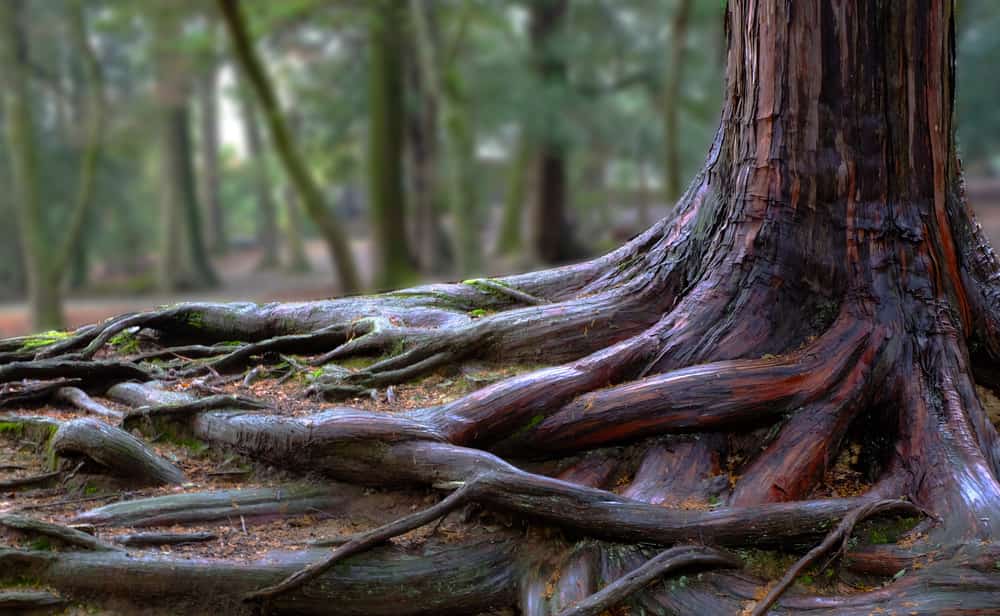Morphology of Roots: The root is a downward growth of the plant into the soil. It is positively geotropic and hydrotropic. Radicle from the germinating seed grows further into the soil to form the root. It produces similar organs. Root does not have nodes or internodes. Branching of the root arises from the pericyclic tissues. Roots are covered by root caps or root heads.
Functions of roots
Table of Contents
- Roots fix the plant to the soil and give mechanical support to the plant body.
- Roots absorb water and the minerals dissolved in it from the soil and transport them to the aerial parts where they are needed.
- At times, the root undergoes modification and performs special functions like storage, respiration, reproduction, etc.
Various parts of a root
A typical underground root exhibits the following parts:
- Root cap: The tip of the root is very delicate and is covered by the root cap. The root cap protects the growing cells and as and when it is worn out it is replaced by the underlying tissues immediately.
- Region of cell division: The next layer of tissue lying immediately after the root cap towards the stem is the meristematic tissue producing new cells, known as the region of cell division or growing region.
- Region of elongation: The newly formed cells in the growing region grow further by elongation in this region increasing the length of the root.
- Region of root hairs: Above the region of elongation is the region of root hairs wherein the root hairs, the unicellular, tubular outgrowths formed by the epiblema are formed. They are responsible for strengthening the hold of roots into the soil and also for the absorption of water.
- Region of maturation: It is located above the region of root hairs. It does not absorb anything but is mainly responsible for the absorbing material by roots. The root branches or the lateral roots are produced in this region.
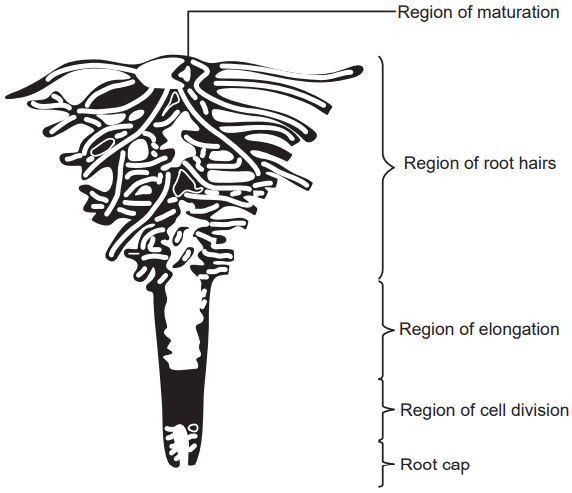
Types of roots
There are two types of root systems:
(a) Taproot system or primary roots and
(b) Adventitious roots.
- Taproot system: The radicle grows into the soil and forms the main axis of the root known as the taproot. It grows further to produce branches in the acropetal manner known as secondary roots which further branches to give tertiary roots. These are all true roots. This system is characteristic of dicotyledons.
- Adventitious root system: The roots that develop from any part of the plant other than the radicle are termed adventitious roots. They may develop from root base nodes or internodes. This type of root system is found in monocots and pteridophytes.
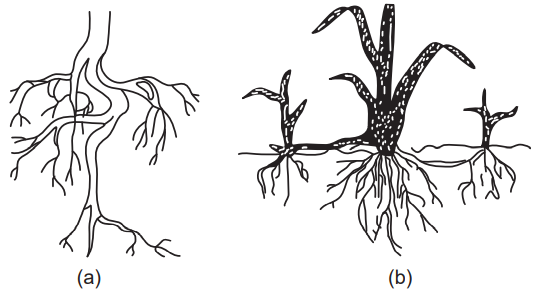
I. Modification for storage of food
This type of modification is shown by both the types of roots, i.e. tap roots and adventitious roots. They store carbohydrates and are used during the early growth of the successive season.
(i) Tap roots show the following three types of modifications:
- Conical: These are cone-like, broader at the base, and tapering at the tip, e.g. carrot.
- Fusiform: These roots are more or less spindle-shaped, i.e. tapering at both the ends, e.g. radish.
- Napiform: These are spherical shaped and very sharply tapering at the lower part, e.g. beat and turnip.
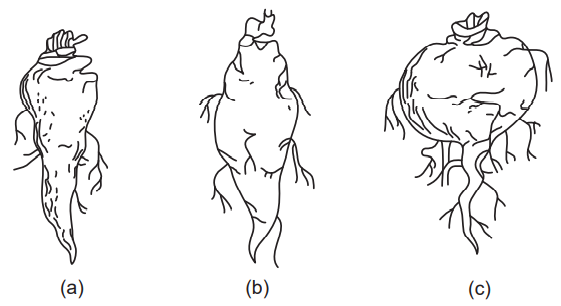
(ii) Adventitious roots show the following types of modifications. They store carbohydrates but do not assume any special shape.
- Tuberous roots: These get swollen and form single or isolated tuberous roots which are fusiform in shape, e.g. sweet potato, jalap, aconite.
- Fasciculated tuberous roots: When several tuberous roots occur in a group or cluster at the base of a stem they are termed as fasciculated tuberous roots as in dahlia, asparagus.
- Palmated tuberous roots: When they are exhibited like a palm with fingers as in a common ground orchid.
- Annulated roots: The swollen portion is in the form of a series of rings called annulus as in ipecacuanha.
II. Modifications for support
The plant develops special aerial roots to offer additional support to the plant by way of adventitious roots.
- Clinging or Climbing roots: These types of roots are developed by plants like black pepper for support or climbing purposes at nodes.
- Stilt roots: This type of root is observed in maize and screw-pine, which grow vertically or obliquely downwards and penetrate the soil and give additional support to the main plant.
- Columnar roots: In certain plants like banyan, the additional support is given by specially developed pillars or columnar roots. They even perform the function of regular roots.
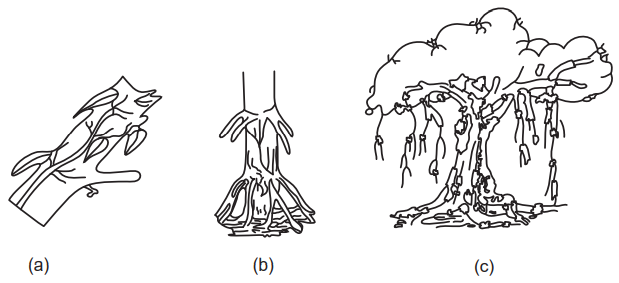
III. Modifications for special functions
- Respiratory roots or pneumatophores: The roots of the plant growing in marshy places on seashores due to continuous water-logging are unable to respire properly. They develop some roots growing against the gravitational force (in the air) with minute openings called lenticels. With the help of lenticels, they carry on the exchange of gases. They look like conical spikes around the stems. This type of root is observed in the case of plants called mangroves found in creeks, i.e. Avicennia.
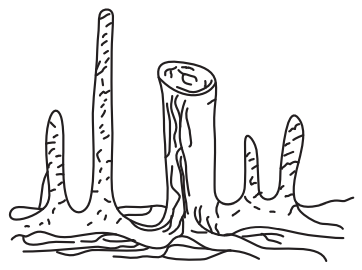
- Sucking roots or Haustoria: The plants, which are total parasites on the host, develop a special type of roots for absorption of food material from, the host. These roots neither possess root caps nor root hairs and are known as sucking roots, e.g. Cuscuta, Striga, and Viscum.
- Photosynthetic roots: Aerial roots in some cases, especially in leafless epiphytes become green in color on exposure to sunlight and perform photosynthesis and are known as photosynthetic roots as in the case of Tinospora cardifolia.
- Epiphytic or Assimilatory roots: The plants which grow on the branches or stems of the plants without taking any food from them are called epiphytic and the roots developed by them are the epiphytic roots. They consist of the following: (i) Clinging roots with which they get fixed with the host and (ii) Aerial roots which hang freely in the air, which are normally long greenish-white in color and absorb moisture from the atmosphere with the help of porous tissue. These roots are devoid of root caps and root hairs. They carry on photosynthesis. These are developed in the plants growing in a humid atmosphere. Bulbophyllum, uanda are examples of this type.
- Nodulated roots or root tubercles: The plants belonging to the Leguminosae family develop nodules or tubercles. These are formed by nitrogen-fixing bacteria and getting carbohydrates from the plants. Roots and bacteria are symbiotic to each other. These swellings developed by roots are nodulated roots.
Uses of roots
- Source of food and vegetables: Most of the vegetables constitute roots only, i.e. radish, turnip, beet, carrot, etc. They are rich sources of vitamins or precursors. Some of them like sweet potato and tapioca are rich in starch and hence are consumed as food.
- Various types of medicinally important drugs are obtained from roots.
Make sure you also check our other amazing Article on : Cell Division
